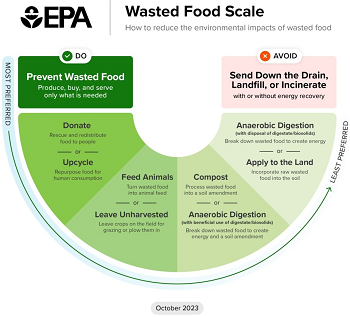A Win for Composting: The Wasted Food Scale
Print this Article | Send to Colleague
 On Oct. 26, the compost industry received a gift from the Environmental Protection Agency (EPA) that we’ve been hoping for more than a quarter century.
On Oct. 26, the compost industry received a gift from the Environmental Protection Agency (EPA) that we’ve been hoping for more than a quarter century.
There’s a new Food Recovery Hierarchy in town that finally recognizes composting for its value to soil, not the landfill diversion that is such a limiting benefit. The Wasted Food Scale (WFS) moves compost up from the lowly place below “industrial uses” and moves us right alongside anaerobic digestion, when the digestate is put to beneficial use.
This is a major acknowledgment that every USCC member should embrace with confidence and share with your local policymakers and advocates, customers and suppliers, educators and recycling/public works offices. Let’s get this out there! (By the way, we agree that prevention, upcycling/rescue, and feeding people/animals are important steps before waste food is composted.)
In a recent press release, Executive Director Frank Franciosi said, "Compost-the product-has the unmatched capacity to enable climate resilient landscapes through actively improving soils and managing for environmental stressors such as flooding and drought. It actively replenishes the soil with an amendment that sequesters carbon, increases water retention, increases soil health, and reduces soil erosion."
It’s illuminating that in its Wasted Food Scale, the EPA highlights the “beneficial use” of digestate, the material leftover after production of biogas in an A/D system. We at USCC have always believed the most beneficial use of digestate is to use it as a composting feedstock, where it will end up with the additional fungi and microbes that characterize nutrient cycling (the back and forth of nutrient consumption and decomposition).
The reports released alongside the WFS also note that as energy demand moves away from fossil fuels (including production of fertilizer) in coming years, the value of biogas will decrease as well, yet compost and similar carbon sequestering products such as biochar will hold their value over time.
We would have preferred that the EPA, on its page describing the scale, would have used the official definition of compost that we have been working hard to get into legislation and regulations. For now though, we’ll take the win!
For a roundup, see the BioCycle Connect article on the replacement of the hierarchy.

